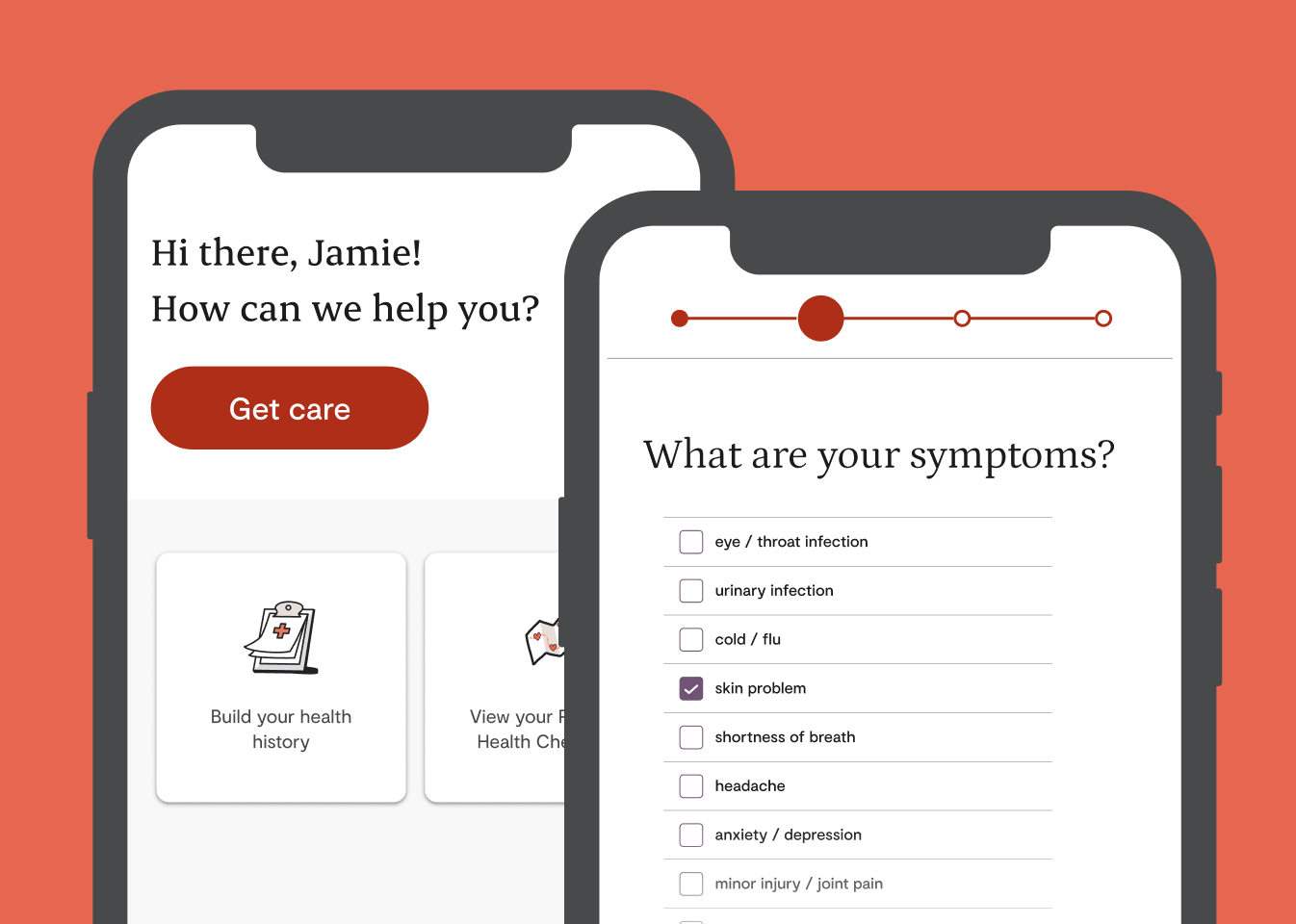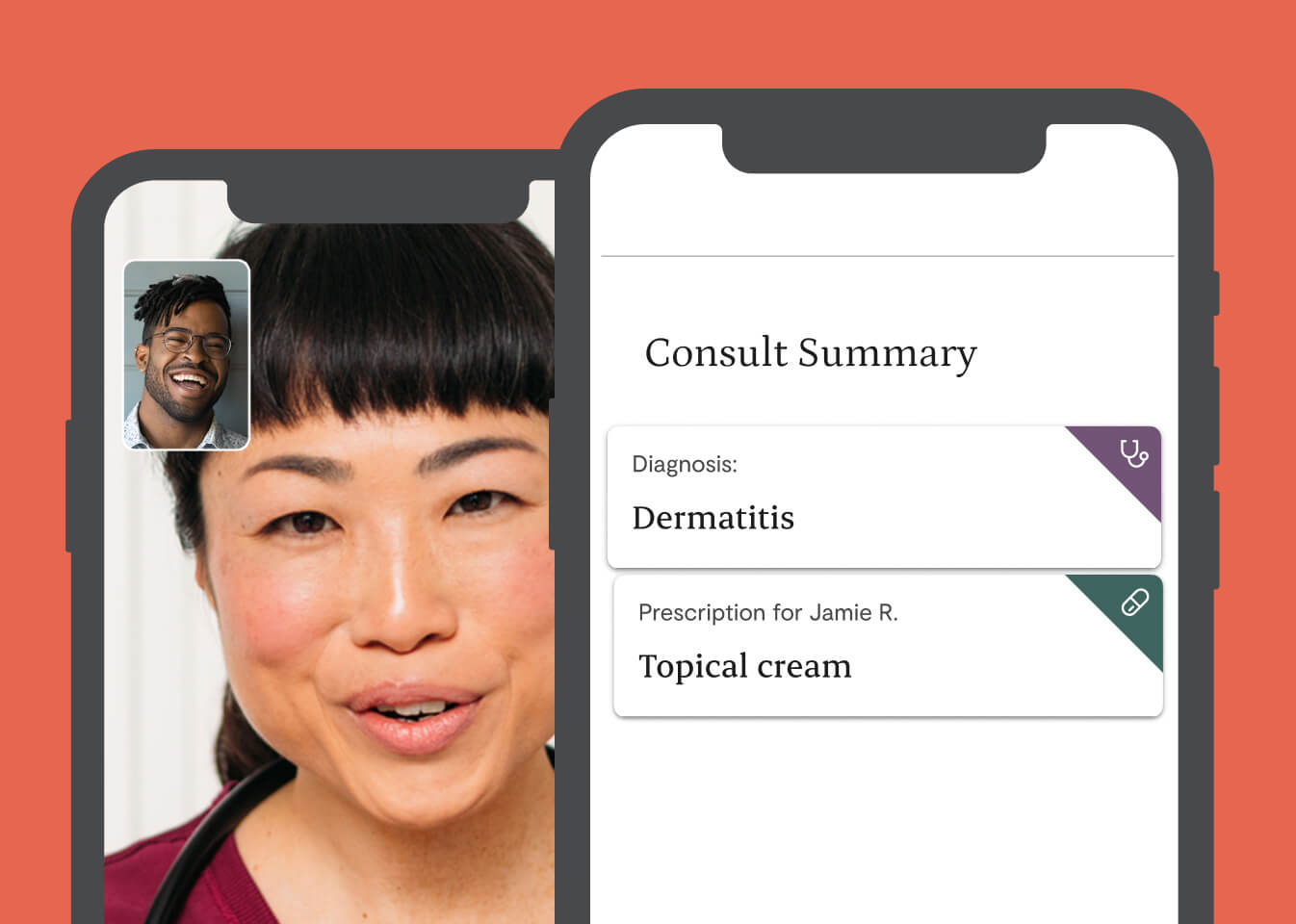Pigment disorders treatment, diagnosis & prescriptions
Skip the waiting room! Instantly connect with Canadian doctors for medical care from your phone, tablet or computer - any time, 24/7.

- Prescriptions available at a provider's discretion
- Speak to a doctor or nurse practitioner
- 24/7 availability
- Get connected in minutes
Trusted by millions of Canadians
- 4.8 rating30K+ App Store reviews
- 4.6 score5K+ Trustpilot reviews
Talk to a doctor about pigment disorders treatment online
See a doctor or nurse practitioner today to get a new prescription or refill, at their discretion.
See a provider in three easy steps.
- 1
Register and become a member

- 2
Select the “Get care” button on our homepage

- 3
Connect with a Canadian-licensed doctor or nurse practitioner in minutes

Why Canadians love Maple
A fantastic way to get medical advice when you are unable to see someone in person. The app is so simple to use. Highly recommend. I am not a tech savvy person but the doctor was kind enough to patiently walk me through every step of the process. Thank you.
Saved me hours waiting in the ER.
Fast and effective tool for getting a diagnosis and prescription.
The doctor willingly took the time to explain things to me.
Very easy to book a therapist and get appointment receipts.
Frequently asked questions
About Pigment Disorders
Yes, you can. The healthcare provider will want to discuss the symptoms or signs of pigment disorders that you’re experiencing. They’ll also want to discuss your personal and family medical histories, as well as perform a physical exam.
In many cases, the healthcare provider could refer you to a dermatologist, who will specialize in identifying specific pigment disorders. They may also suggest additional testing on the affected area, to rule out possible underlying conditions causing your pigment disorder.
Once you have a pigment disorder diagnosis, the healthcare provider or dermatologist can suggest appropriate pigment disorder treatments, if any are available for your condition.
Yes, our physicians can prescribe pigment disorder medications online during your consultation. Once you accept a prescription for pigment disorders, you’ll have the option to pick it up from any pharmacy or to have it delivered right to your door at no additional cost.
Pigmentation refers to the colour of our skin. More specifically, it’s used to describe a pigment called melanin, created by special cells in our skin.
When these special cells become unhealthy or get damaged, melanin production is affected. Pigment disorders refer to skin conditions caused resulting from changes in our skin colouring. Some of these conditions may be contained to a small area of the body, while others could affect the whole body.
Each different type of pigment disorder has its own symptoms. Some pigment disorders, like birthmarks, may have no symptoms other than their appearance. As their name suggests, they’re typically found shortly after birth, and aren’t usually a cause for concern.
Other types of pigment disorders are identified by the size, shape, colour changes, or location of the affected skin. There may be no additional signs of these pigment disorders other than the effects they have on the colour of our skin.
Albinism often affects the entire body. This pigment disorder has symptoms that affect both the eyes and hair.
The exact causes for certain pigment disorders, like birthmarks, aren’t fully understood. All pigment disorders result from some change in the melanin in our skin.
Albinism is an inherited condition, so this pigment disorder is caused by genetics.
Melasma is caused by changes in the hormone estrogen, which is why it’s more commonly found in women than men. This condition can sometimes be triggered by pregnancy, and fade on its own when hormone levels return to normal.
Both hyperpigmentation and hypopigmentation are pigment disorders that are caused by damage to skin.
Vitiligo is an autoimmune disease, so this condition is a result of our own immune system attacking pigment cells.
Infant Jaundice is caused by an excess of bilirubin in the baby’s blood, which is a yellow pigment produced when red blood cells are broken down. Bilirubin (a yellow substance) is normally removed from the blood in the liver. Levels become high, and potentially toxic when too much bilirubin is made faster than it can be removed.
In order to diagnose pigment disorders, the healthcare provider will want to discuss your personal and family medical histories. They’ll also want to check any signs of pigment disorders you’re showing and perform a physical exam.
Sometimes, the healthcare provider may refer you to a dermatologist. This is a skin specialist, who has the expertise necessary to offer a clear pigment disorder diagnosis. They can also suggest any specialized testing that may be required to identify your specific condition, including a biopsy on the affected area.
Once you have a clear pigment disorder diagnosis, the healthcare provider can suggest appropriate pigment disorder treatments for your condition, when available. This includes any prescription pigment disorder medications you may require.
The type of pigment disorder treatments your healthcare provider will suggest depends on what they believe the cause of your pigment disorder to be.
In some cases, there may not be a direct treatment for your pigment disorder. However, the healthcare provider could suggest therapy treatments for the mental health effects pigment disorders can cause.
Certain pigment disorders can be treated with over-the-counter medications, lotions, and creams, while others may require prescription pigment disorder medications.
In some cases, your healthcare provider may suggest additional treatments or therapies, such as:
- Laser resurfacing
- Chemical peels
- Dermabrasion therapy
- Light therapies
If you’ve noticed changes with your skin pigment, you should talk to your healthcare provider. While many pigment disorders aren’t painful, they can have a negative effect on our mental health and self-image.
A healthcare provider from Maple can refer you to a dermatologist on our platform. Together your healthcare team can help diagnose your pigment disorder and suggest treatments best suited to you.
Don’t be embarrassed by pigment disorders. Let Maple help you take control of your pigment disorder symptoms.
Maple 101
Maple is a virtual care platform that connects you with doctors and other healthcare providers via text, audio, or video. After you log in to your Maple account, you can request an online consultation.
Consultations work similarly to in-person appointments — the doctor can complete an assessment by asking questions about your symptoms, going through your health history, and determining what treatment is right for you. If they think your condition is more serious, they may tell you to go to a clinic for an in-person examination.
As a Maple member, you get 24/7 access to virtual primary care online and more. You can connect with our network of providers via text, audio, or video call within minutes.
Pricing and Payment
Our membership costs $79.99/month and covers virtual care for patients and their families, including the primary account holder's spouse and any dependents.
For patients in eligible provinces, our membership includes:
- Access to daily primary care provider visits: One daily visit with a primary care provider for each family member in their household.
- Paediatric care: Covered paediatric primary care visits, available by appointment.
- Second medical opinions: access to a network of experts for a second opinion if diagnosed with a complex condition (e.g. cancer).
- Personal Health Check-Ins: A series of personalized, evidence-based proactive care screenings to maintain and improve health.
- iCBT courses: Access to iCBT (internet-based cognitive behavioural therapy) self-assessment and courses.
- Access to specialists in eligible provinces: Easy access to specialists on Maple within days, not months. No referral is needed.
- Specialist referrals in eligible provinces: Ability to be referred to a physician specialist for in-person care, if needed.
- Credit discounts: An $80 credit per month to be applied to a Maple specialist visit.
Please note that our membership cannot be combined with other offerings, such as private insurance coverage and provincial programs, where available. In some cases, membership fees can be covered by a Healthcare Spending Account (HSA) — check with your HSA provider for more details.
We accept all major credit cards, including AMEX cards, as well as Google and Apple Pay.
Security and Privacy
At Maple, we proudly prioritize privacy as a cornerstone of our virtual care services. We strictly adhere to privacy and healthcare legislation in Canada, such as PIPEDA and PHIPA regulations, to ensure patients' personal and health information remains completely private and safeguarded.
Our policies and consent processes are designed to be simple and easily understood, empowering individuals with control and a clear understanding of their healthcare journey. When using our services, a patient’s session is protected by a comprehensive security infrastructure and stringent data policies.
Patients also retain full control of their personal health information, medical records and test results at all times. Our approach is reinforced by consultations with leading experts, guaranteeing comprehensive policy frameworks that are reviewed at a regular cadence.
All providers delivering healthcare through Maple are licensed in Canada and governed by their licensing regulatory colleges, and in all instances, must act in accordance with the governing principles set out in the telemedicine policies of each medical regulator in the applicable province.
Regulators across Canada support and recognize the value of services like ours, and the way in which they can benefit patients, physicians, and Canada’s broader healthcare system by improving access to care and increasing efficiencies in the delivery of care.
Do you need medical care today?
Trusted, experienced doctors and nurse practitioners are ready to see you.
Maple is safe and effective for common non-emergency issues. If you believe you are experiencing an emergency, please call 911 or proceed to your nearest emergency room.










